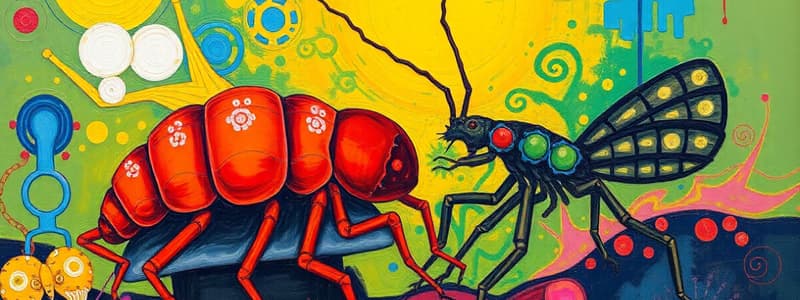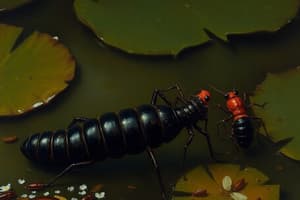Podcast
Questions and Answers
What is the definition of parasitism?
What is the definition of parasitism?
- One species benefits at the expense of another. (correct)
- Both species are harmed during the interaction.
- Neither species is affected by the relationship.
- Both species benefit from the interaction.
Ectoparasites live inside their hosts.
Ectoparasites live inside their hosts.
False (B)
What is an example of a roundworm that commonly infects humans?
What is an example of a roundworm that commonly infects humans?
Ascaris lumbricoides
Mistletoe obtains water and mineral nutrients from its ______.
Mistletoe obtains water and mineral nutrients from its ______.
Match the following types of parasites with their descriptions:
Match the following types of parasites with their descriptions:
What type of organism is typically harmed in a parasitic relationship?
What type of organism is typically harmed in a parasitic relationship?
Parasites usually kill their hosts.
Parasites usually kill their hosts.
How is a roundworm infection typically contracted?
How is a roundworm infection typically contracted?
Parasites can outnumber free-living species by about ______ to one.
Parasites can outnumber free-living species by about ______ to one.
What can be a negative effect of parasitism on the host?
What can be a negative effect of parasitism on the host?
What type of organism are roundworms and tapeworms categorized as?
What type of organism are roundworms and tapeworms categorized as?
Ectoparasites like fleas only feed from their hosts at specific times.
Ectoparasites like fleas only feed from their hosts at specific times.
What is the primary disease caused by the parasite Plasmodium falciparum?
What is the primary disease caused by the parasite Plasmodium falciparum?
Lice can be treated with special ______ and lice combs.
Lice can be treated with special ______ and lice combs.
Match the type of parasite with their description:
Match the type of parasite with their description:
Which of the following is an example of a commensal relationship?
Which of the following is an example of a commensal relationship?
Parasites can infect both animals and plants.
Parasites can infect both animals and plants.
What do adult worms produce once they mature in the host's intestines?
What do adult worms produce once they mature in the host's intestines?
The parasite ______ is predominantly spread by mosquitos.
The parasite ______ is predominantly spread by mosquitos.
Match the following external parasites with their feeding behaviors:
Match the following external parasites with their feeding behaviors:
Flashcards
Parasitism
Parasitism
A relationship where one organism (parasite) benefits and another (host) is harmed.
Parasite
Parasite
The organism that benefits in a parasitic relationship.
Host
Host
The organism that is harmed in a parasitic relationship.
Ectoparasite
Ectoparasite
A parasite that lives on the outside of its host.
Signup and view all the flashcards
Endoparasite
Endoparasite
A parasite that lives inside its host.
Signup and view all the flashcards
Mistletoe
Mistletoe
An example of a parasitic plant.
Signup and view all the flashcards
Roundworm
Roundworm
A type of endoparasite that affects various animals, including humans.
Signup and view all the flashcards
Fecal-oral route
Fecal-oral route
Method of transmission of roundworm eggs, where contamination of food or water from feces occurs.
Signup and view all the flashcards
Ascaris lumbricoides
Ascaris lumbricoides
A common type of roundworm that infects humans.
Signup and view all the flashcards
Parasitic infection
Parasitic infection
Infection caused by parasitic organisms.
Signup and view all the flashcards
Endoparasite
Endoparasite
An organism that lives inside another organism (the host) and benefits from it, harming the host in the process.
Signup and view all the flashcards
Ectoparasite
Ectoparasite
An organism that lives on the outside of another organism (the host) and benefits from it, sometimes harming the host in the process.
Signup and view all the flashcards
Parasitism
Parasitism
A symbiotic relationship where one organism (parasite) benefits at the expense of another (host).
Signup and view all the flashcards
Roundworm lifecycle
Roundworm lifecycle
Roundworms reproduce and spread by infecting host. Infested host coughs up larvae, swallowed, matured in intestines, producing fertilized eggs, continuing the cycle.
Signup and view all the flashcards
Tick
Tick
Ectoparasite that infests skin and fur, feeding on host blood. Potentially causes disease.
Signup and view all the flashcards
Fleas
Fleas
Ectoparasites that live on their host, feeding on blood, causing itching.
Signup and view all the flashcards
Commensalism
Commensalism
A symbiotic relationship where one organism benefits, and the other is neither harmed nor helped.
Signup and view all the flashcards
Malaria
Malaria
Disease caused by the Plasmodium parasite, primarily transmitted by mosquitoes.
Signup and view all the flashcards
Lamprey
Lamprey
An ectoparasite that attaches to a host using a sucker mouth to feed on blood and tissues.
Signup and view all the flashcards
Lice
Lice
Ectoparasites that infest humans, affecting body, head, or pubic areas.
Signup and view all the flashcardsStudy Notes
Parasitism
- Parasitism is a symbiotic relationship where one species (the parasite) benefits, and the other (the host) is harmed.
- The parasite lives on or in the host and usually feeds off it.
- Parasites can be animals (e.g., tapeworms), insects (e.g., ticks), or fungi (e.g., some fungal species causing tinea or athlete's foot). They can also be plants (e.g., mistletoe).
- Parasites don't always kill their host.
- Some examples of parasites include: ticks, mistletoe, parasitic fungi, roundworms, fleas, and lice (body, head, and pubic).
- Roundworms can affect pigs, cows, sheep, dogs, and humans.
- Ascaris lumbricoides is a parasitic roundworm common in humans.
- Roundworms and tapeworms are endoparasites found in the gut of mammals.
- They get food from their host's partly digested food.
- North American bighorn sheep are frequently parasitized by lungworms.
- Lampreys attach themselves to their host's body and feed on the blood and tissues.
- Plasmodium Falciparum is a single-celled parasite causing malaria; spread by mosquitoes.
Ectoparasites
- Ectoparasites live on the outside of their host.
- Examples include ticks, mistletoe, fleas, and lice.
- Fleas live their whole life on a host, while ticks and leeches feed on their host at specific times.
- Lice are treated with special shampoo and combs.
Endoparasites
- Endoparasites live inside their host.
- Examples include roundworms, tapeworms, and some fungi.
- Roundworms and tapeworms live in the gut of mammals.
Mistletoe
- Mistletoes are ectoparasites that grow on other plants.
- They take nutrients and water from their host plant.
Roundworms
- The Ascaris lumbricoides roundworm affects humans via the fecal-oral route.
- Fertilized eggs are shed in human feces, and infection occurs when swallowed water or food is contaminated with eggs.
- In humans, larvae hatch in the intestines, penetrate the bloodstream, and travel to the lungs.
- Then they are coughed up, swallowed, and mature into adult worms in the intestines.
Commensalism
- Commensalism is a symbiotic relationship where one species benefits and the other is not affected.
- Animals like birds or possums nesting in tree hollows benefit, while the tree is unaffected.
- Epiphytes (e.g., orchids, ferns, mosses, liverworts, and lichens) growing on trees benefit since they get sunlight and water. Trees are usually unaffected.
- Remoras fish attach to larger predatory fish (e.g., sharks) to feed off uneaten food scraps. The shark is unaffected.
- Barnacles attach to whales for free transport. The whale is unaffected.
Studying That Suits You
Use AI to generate personalized quizzes and flashcards to suit your learning preferences.



